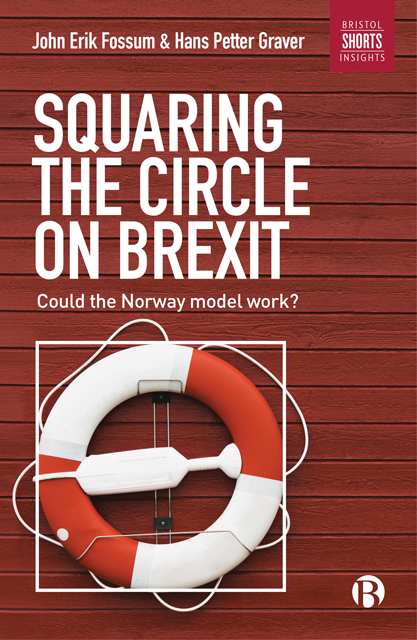Book contents
- Frontmatter
- Contents
- Foreword
- Preface and acknowledgements
- List of abbreviations
- Introduction
- 1 What does Britain want from Brexit?
- 2 Forms of affiliation with non-members
- 3 What is the Norway model?
- 4 The challenge of sovereignty
- 5 What can Britain learn from Norway’s experience?
- 6 Would Britain be an ‘elephant in the boat’?
- Conclusion
- Notes
- References
- Appendix
- Index
2 - Forms of affiliation with non-members
Published online by Cambridge University Press: 21 April 2023
- Frontmatter
- Contents
- Foreword
- Preface and acknowledgements
- List of abbreviations
- Introduction
- 1 What does Britain want from Brexit?
- 2 Forms of affiliation with non-members
- 3 What is the Norway model?
- 4 The challenge of sovereignty
- 5 What can Britain learn from Norway’s experience?
- 6 Would Britain be an ‘elephant in the boat’?
- Conclusion
- Notes
- References
- Appendix
- Index
Summary
This chapter provides a brief overview of the EU’s range of affiliations with non-members. The purpose of the chapter is threefold. First, the aim is to show that while the EU has elements of stateness ‒ as Genschel and Jachtenfuchs (2014) note, it has moved into core state powers and the member states lend it their stateness ‒ it has developed a distinct approach to borders and bordering that greatly conditions its relations to members and non-members, regardless of the type of affiliation involved. That shows an EU readiness to adapt its relations to its surroundings, and is clearly of relevance for the UK government’s focus on bespoke agreements. Whereas the EU is adaptive to its surroundings, it is not without principles and even strict legal rules. There are guidelines, frameworks and clear legal limits that shape how the EU fashions its external relations, which reflect back on the EU’s structure and self-conception as a legal and political system, including its approach to borders and bordering. We need to pay attention to the EU’s treaties as well as its principles and guidelines in order to get a handle on the wiggle-room that is available for non-members.
The second purpose of the chapter is to provide a brief overview of the sheer range of off-the-shelf modes of affiliation already out there. It is beyond the scope of this book to provide a set of compelling explanations for the nature and range of this broad spectrum of EU affiliations. What is readily apparent is that there are so many and such diverse states bordering the EU that it is difficult to imagine this diversity will not also shape the EU’s external relations.
The third and final purpose of the chapter is to zoom in on and provide a brief overview of the Swiss model. This chapter thus helps to conceptualise the discussion of the Norway model as one among a broad range of modes of affiliation.
The EU and the question of borders and bordering
The EU’s openness to its surroundings is apparent in the fact that membership is possible for all European states (even if it is readily apparent that some long-term applicants such as Turkey are unlikely ever to become members), though EU membership is conditional on compliance with a range of criteria, namely the so-called Copenhagen criteria.
- Type
- Chapter
- Information
- Squaring the Circle on BrexitCould the Norway Model Work?, pp. 27 - 40Publisher: Bristol University PressPrint publication year: 2018

